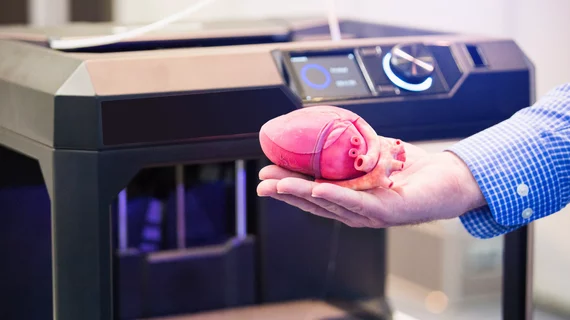AHA.18: Where cardiac 3D printing falls short
As 3D printing continues to gain traction as a medical treatment tool, cardiologists across the globe are implementing the technology in their own departments and practices. But as they do, one radiologist cautions, it’s important they consider some critical groundwork that’s yet to be laid.
For years, physicians have lauded 3D printers as planning tools for complex cardiac surgeries and facilitators for patient engagement. In a 2016 paper published in Nature Reviews, Andreas A. Giannopoulos et al. wrote cardiovascular 3D printing enhances diagnostic workup, improves patient understanding of conditions and promotes shared decision-making between primary care providers and their patients.
The researchers suggested cardiovascular 3D bioprinting and molecular 3D printing hold “great promise,” but they also admitted the widespread adoption of 3D printing is limited by a dearth of evidence and high price points.
Those barriers concern Frank J. Rybicki, MD, PhD, a longtime radiologist and chief of medical imaging at The Ottawa Hospital in Canada. He said the cardiovascular applications of 3D printing have been apparent since its inception, especially in the areas of structural heart disease and valve repair.
At the American Heart Association’s 2018 Scientific Sessions in Chicago, Rybicki said cardiovascular 3D printing can play an invaluable role in treatment planning, and there are copious ways cardiologists can work with 3D models. They might test a novel device in a printed heart model, or they might 3D-print the device itself and play with its structure in the context of live tissue.
3D printing can originate with a CT scan, an MRI, a 3D echo or another imaging study, Rybicki said, and that variability is part of what makes the technology so widely applicable. But in other areas the field is more narrow, including in its regulation.
“As physicians that are taking care of patients, there is no self-regulatory body,” Rybicki said. “So the RSNA (Radiological Society of North America) tried to fill that void with the creation of the Special Interest Group. Tried to fill that void so that we could regulate ourselves in this space, so we could actually make the guidelines and the rules and do the right thing.”
But there fails to be an industry standard for 3D printing, he said. If physicians want to print at their hospitals, they’ll be subject to rigid regulations on behalf of the FDA. Approaching individual manufacturers themselves won’t work, either—those manufacturers are also heavily regulated by the government, and it will likely be difficult for cardiologists to get their hands on a unique model, device or valve.
Rybicki said he expects some of the bigger players in heart health to step up with more in-depth recommendations—“I believe that the cardiology societies are going to do that very, very soon”—but at the end of the day, there need to be standards.
“We’d better make some rules,” he said. “Because otherwise, you can have willy-nilly 3D printing. Anything can actually happen. You can 3D print off your iPhone if you have the right hook-ups, right? But we don’t want that. We want to do really high-quality work.”
He said the field needs more scholarship, registries and multicenter trials to take 3D printing to the next level and help guide societies in implementing safe and effective practices.
“The papers that we have, I’ll be honest with you, they’re not that great,” Rybicki said. “We have to do better.”
And that includes the fourth prong of healthcare’s established quadruple aim: provider well-being. Rybicki said beyond guidelines we need human resource standards, like quality training for technologists and programs for staff and residents. Without those additions, he said, physicians won’t be able to thrive creatively alongside this new technology.
“We’re doing this artistic work in some ways,” he said. “We’re not trying to distort, in most cases, but we are being very artistic. So we’re trying to do the right thing, and you have to have the right training to do so.”

